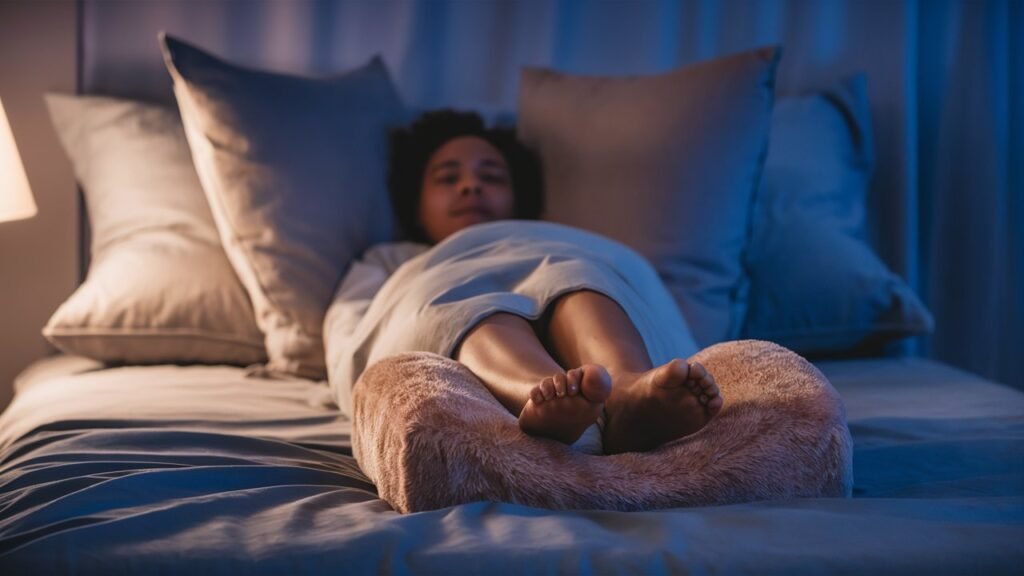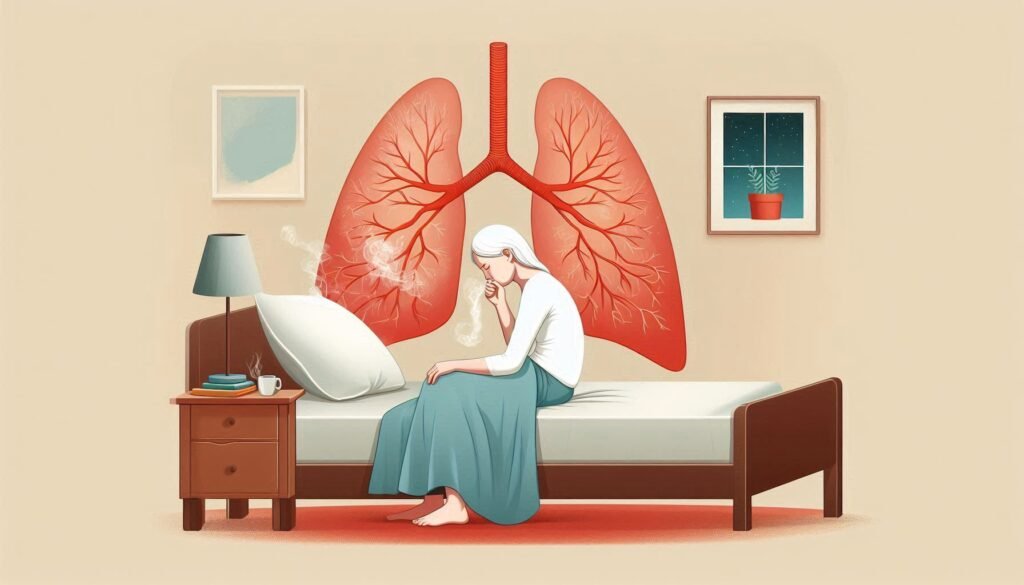Many people experience discomfort during the night, whether it’s breathlessness or sudden leg pain. These issues can disrupt sleep and lead to a restless morning. Two common culprits behind nighttime disturbances are orthopnea and nocturnal leg cramps. While they may seem similar at first glance, understanding their differences is crucial for effective management.
Orthopnea refers to difficulty breathing while lying down, often associated with heart conditions or respiratory issues. Nocturnal leg cramps, on the other hand, involve painful muscle contractions that typically occur in the calf muscles during sleep. Recognizing these distinct symptoms can help you seek appropriate treatment and improve your overall quality of life.
In this article, we’ll delve into the nuances between orthopnea and nocturnal leg cramps—exploring causes, symptoms, treatments, and lifestyle changes that can enhance your nighttime comfort. Understanding these two conditions will empower you to take control of your health as you work towards restful nights ahead!

Understanding the difference: Orthopnea and nocturnal leg cramps explained
Orthopnea and nocturnal leg cramps may both disrupt your sleep, but they stem from different physiological issues. Orthopnea specifically refers to the sensation of breathlessness that occurs when lying flat. This condition is often linked to underlying heart or lung problems, causing fluid buildup in the lungs and making it difficult for individuals to breathe comfortably at night.
On the other hand, nocturnal leg cramps are sudden, involuntary contractions of the muscles in your legs, particularly in the calves. These painful spasms can wake you up abruptly during sleep and typically last from a few seconds to several minutes. Unlike orthopnea, which affects breathing patterns, these cramps primarily involve muscle function.
While both conditions can lead to disrupted restfulness at night, their origins differ significantly. Understanding whether you’re dealing with orthopnea or nocturnal leg cramps is essential for seeking appropriate treatment options tailored to each issue’s unique needs.
Recognizing these differences empowers you with knowledge about your symptoms and helps guide conversations with healthcare professionals regarding potential interventions.
Common causes: Why you might experience breathlessness or leg pain at night
Breathlessness at night, known as orthopnea, can be caused by several underlying issues. Heart conditions, such as congestive heart failure, lead to fluid buildup in the lungs when lying down. This often results in difficulty breathing and shortness of breath during sleep.
Nocturnal leg cramps are another common complaint. These painful muscle contractions usually occur due to dehydration or electrolyte imbalances. Factors like excessive exercise or prolonged sitting during the day can also trigger nighttime cramps.
Certain medications may contribute to either condition. Diuretics prescribed for high blood pressure can increase fluid loss and lead to cramping while affecting lung function if too much fluid is removed from the body.
Additionally, sleeping position plays a role in both discomforts. Lying flat may exacerbate breathing difficulties for some individuals with respiratory conditions, while certain positions might restrict blood flow and cause leg pain during the night.
Recognizing the symptoms: How to tell if it’s your breathing or your legs
Recognizing the symptoms can be crucial in differentiating between orthopnea and nocturnal leg cramps. Orthopnea typically presents as shortness of breath that worsens when lying flat. Patients may find relief by propping themselves up with pillows or sleeping in a reclined position. This breathing difficulty often arises suddenly, especially during the night.
In contrast, nocturnal leg cramps are usually characterized by sudden, intense pain or discomfort in one or both legs. These cramps tend to occur during deep sleep and can wake you abruptly. The pain may feel like a tight knot in your muscle and usually lasts for a few minutes before gradually subsiding.
Pay attention to accompanying symptoms as well. If you’re experiencing chest tightness along with breathing difficulties, it could indicate something more serious than orthopnea alone. Conversely, if you notice swelling around your legs or persistent soreness after cramping episodes, further investigation might be warranted.
Understanding these signs is key to identifying which condition is affecting your nighttime rest and determining the right course of action moving forward.
When to worry: Red flags that suggest a more serious underlying condition
It’s essential to recognize when nighttime discomfort might signal something more serious. If you experience persistent breathlessness while lying down, it could indicate orthopnea related to heart issues or lung problems. This symptom warrants immediate medical attention, especially if accompanied by chest pain.
Leg cramps can also be a source of concern. If your nocturnal leg cramps are severe and frequent, they might suggest underlying vascular or neurological conditions. Pay attention if the pain lasts longer than usual or is accompanied by swelling in the legs.
Unexplained weight loss, dizziness, or fatigue accompanying these symptoms should never be ignored. These signs could point toward systemic issues that require evaluation by a healthcare professional.
If breathing difficulties worsen during physical activity or lead to episodes of fainting, it’s time to seek help. Early intervention can make a difference in managing any potential underlying health concerns effectively.
Diagnostic approaches: How doctors differentiate between these conditions
When a patient presents with symptoms of orthopnea or nocturnal leg cramps, doctors begin by taking a detailed medical history. They’ll ask about the onset, duration, and frequency of symptoms. Understanding any underlying health conditions is essential in guiding the diagnostic process.
Next, a physical examination allows physicians to assess respiratory function and check for signs of circulatory issues. They may listen to heart sounds and evaluate lung capacity through tests like spirometry. This helps distinguish between respiratory-related discomfort and musculoskeletal pain.
Imaging studies such as chest X-rays or echocardiograms can further clarify whether fluid accumulation around the lungs is causing orthopnea. For nocturnal leg cramps, ultrasound might be used to examine blood flow in the lower extremities.
Depending on findings, additional tests such as sleep studies could be conducted if sleep apnea is suspected alongside orthopnea. These comprehensive methods allow healthcare providers to pinpoint the exact cause and tailor interventions effectively.
Treatment strategies: Managing orthopnea vs. relieving leg cramps
Managing orthopnea often requires a multi-faceted approach. Elevating the head while sleeping can significantly improve breathing comfort. Patients may also benefit from using extra pillows or investing in an adjustable bed. For individuals with heart conditions, medications such as diuretics might be prescribed to reduce fluid buildup.
On the other hand, relieving nocturnal leg cramps typically involves stretching and hydration strategies. Gentle calf stretches before bedtime can help prevent these painful episodes. Staying well-hydrated throughout the day is essential, as dehydration can contribute to cramps during sleep.
If symptoms persist, healthcare providers may recommend muscle relaxants or specific supplements such as magnesium and potassium. These nutrients play a crucial role in muscle function and may alleviate cramping sensations for some individuals.
In both cases, identifying underlying causes is key to effective treatment. Regular follow-ups with a healthcare provider ensure that any necessary adjustments are made to medication regimens or lifestyle choices tailored specifically for managing either condition effectively.
Lifestyle changes: Improving sleep quality for both conditions
Improving sleep quality is crucial for managing both orthopnea and nocturnal leg cramps. One effective lifestyle change is establishing a regular sleep schedule. Going to bed and waking up at the same time each day helps regulate your body’s internal clock, promoting deeper and more restorative sleep.
Creating a calming bedtime routine can also make a significant difference. Activities such as reading or practicing relaxation techniques like deep breathing prepare your mind and body for rest. Avoiding screens at least an hour before bed mitigates blue light exposure, which can interfere with melatonin production.
Physical activity plays an essential role in improving overall health and sleep quality. Aim for regular exercise during the day, as it can help alleviate stress and muscle tension—common contributors to discomfort at night. However, avoid vigorous workouts close to bedtime.
Consider optimizing your sleeping environment. A cool, dark room free from distractions promotes better sleep hygiene. Investing in comfortable bedding may support both comfort levels while addressing symptoms of either condition effectively.
The role of medications: When and how they can help
Medications can play a crucial role in managing both orthopnea and nocturnal leg cramps, but their use varies significantly between the two conditions. For patients experiencing orthopnea, which often stems from heart issues or pulmonary disorders, doctors may prescribe diuretics to reduce fluid buildup. In some cases, bronchodilators or corticosteroids might be recommended to help relieve breathing difficulties.
On the other hand, nocturnal leg cramps might not require medication unless they are frequent or severe. Muscle relaxants can sometimes provide relief for persistent cramping episodes. Additionally, vitamin supplements such as magnesium and potassium may be suggested if deficiencies are identified.
It’s essential to consult with a healthcare professional before starting any medication regimen. Each individual’s health condition is unique; what works for one person may not work for another. Proper diagnosis ensures that treatment is tailored specifically to your needs.
Always monitor how your body responds to medications over time. Adjustments might be necessary based on effectiveness and side effects experienced during treatment.
Prevention tips: Reducing the frequency of nighttime discomfort
To reduce the frequency of nighttime discomfort, start by creating a bedtime routine. Engage in relaxing activities before sleep, such as reading or meditating. This can help calm your mind and prepare your body for rest.
Hydration plays a vital role too. Drink water throughout the day but limit intake before bed to avoid frequent bathroom trips at night. Staying hydrated helps prevent leg cramps while also supporting overall health.
Consider your sleeping position as well. Sleeping on your side with pillows between your legs can alleviate pressure and improve circulation. If you’re prone to orthopnea, elevating your head with an extra pillow may ease breathing difficulties during sleep.
Maintain an active lifestyle through regular exercise. Engaging in gentle activities like walking or stretching promotes better blood flow and reduces muscle tension—factors that contribute to both orthopnea and nocturnal leg cramps over time.
When to seek help: Knowing when it’s time to consult a healthcare professional
Recognizing when to seek help is crucial for managing nighttime discomfort effectively. If you regularly experience breathlessness or leg cramps that disrupt your sleep, it may be time to consult a healthcare professional. Keep an eye out for persistent symptoms that don’t improve with home treatments.
For orthopnea, worrying signs include significant shortness of breath even while resting, difficulty lying flat at night without support, or sudden onset breathing problems. These could indicate underlying conditions like heart failure or severe respiratory issues.
On the other hand, if your nocturnal leg cramps are accompanied by swelling in the legs, changes in skin color, or numbness and tingling sensations, these could signal vascular issues requiring medical attention.
Don’t hesitate to reach out if you’re unsure about your symptoms. A timely consultation can lead to appropriate diagnostics and treatment options tailored specifically for you. Prioritizing your health ensures better nights ahead and enhances overall well-being during waking hours too.


